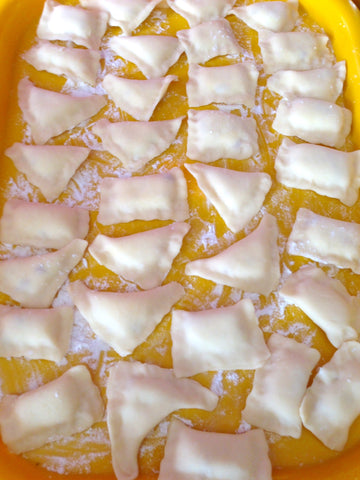Eating High On The Hog
Well, at least knuckle height. There's no need to spend a fortune on meals and groceries here in Poland in order to get your fill of local delicacies. On the contrary, food is reasonably priced if not surprisingly inexpensive. Just look at the many Milk Bars from the Communist era; still serving up decent, standard meals on the dirt cheap. Or a quaint restaurant like Polakowski; where locals roll in, homemade food is served on your grandma's china and you're ready to explode at about $7.00 tops. It affords you the opportunity to try just about anything and everything. Pork knuckle being one of the interesting choices.


Local Polakowski restaurant serving its delicious nalesniki
You best come with a voracious appetite at any sitting, however. This is a country that is not afraid to eat. And boy, do they want you to. Riddled with typically bland (pepper is considered spicy) potatoes, sausages, meats, cheeses, and lots of doughy things, the Polish diet is heavy, hearty, and like never-ending comfort food. The kind of meals where you need to pause multiple times to let out a groaning sigh. And also your pants. You're baited with enticing, artistic treats at cukiernias and warm, fresh breads at piekarnias around every corner. And when you're taking your best shot on pronouncing yummy authentic treats like obwarzanki, zapiekanki, and oscypek (knowing you're sure as hell to sink with embarrassment below the counter like the Titanic), you know the food must be worth it.


Polish street food. Obwarzanki (pretzels sold all around Kraków; symbols of the city) and zapiekanki (hot, open-faced sandwiches with shaved meat, cheese, mushrooms, onions, and ketchup)
As someone who puts almost no restrictions on herself when traveling, particularly when it comes to foreign food, I've really enjoyed all of the above and then some. Warm zurek (a traditional sour, rye soup with bits of meat and egg). Giant kotlety schabowy (think breaded pork chop like schnitzel). Hearty bigos (fermented sauerkraut/meat/mushrooms stew). Not-just-for-dessert nalesniki (delicious whipped cottage cheese-filled Polish pancakes often served with sweet cream...the best). But of course, there is one little doughy pocket of goodness that shadows the rest on any Polish menu. Pierogi.
If you didn't grow up with Polish heritage like I did, the word pierogi (the same in both singular and plural forms, by the way) might have little meaning to you. But I'm hoping to change that. Pierogi (pyah-roh-gee) is probably the most notably traditional Polish food you can get. I remember learning of it as a specialty of the "old country" from my grandparents and parents and it always somehow held a distinctive connotation for me. Like, you didn't have pierogi just any ol' time.
And I found out why. Making pierogi is truly a labor of love. As I got to see first-hand when I excitedly took an in-home Polish cooking lesson from a wonderful young woman, Magda, and her grandma, Krysia. I found this unique opportunity online and, as is the norm when you travel in October, had an amazing morning at Magda's home all by myself! With such graciousness, Magda first took me to the local outdoor market where we hunted down the freshest ingredients for our meal. A uniquely charming scene filled with purely Polish-speaking vendors and stereotypical elderly Polish women enveloped in thick, wool coats, walking with purpose in their strides. We then sped over to her home where her non-english-speaking grandma was waiting to get the pieorogi party started! Perched on a seat, while indulging in some hot coffee, traditional Polish foods, and background music, I stayed out of the way as Krysia's process took a lot of elbow grease. So unfortunately, it was much less of a party for Krysia until I got the call.

Practicing my pierogi-making skills
Time to roll up my sleeves and see what kind of pierogi producer I would be. From the playful scolding I was getting from Krysia, not a good one. Apparently I needed a lot of practice on firmly securing the edges of our doughy dumplings. Press harder, harder, urged Krysia, like a good Polish grandmother. And after several trays of practice, I finally got the thumbs up! The pierogi went in for a 10 minute, boiling water dip which resulted in a delicious and rewarding lunch. Our perfectly-pinched potato pockets and wonderfully-whipped cheese and onion filling smelled and tasted heavenly. Even better, the company of Magda and Krysia, who shared a leisurely, humble slice of Polish life with me that day.
Simple ingredients. Simple dish. Simple day. No need for lavish fare or pork of any kind. It was simply one of the most memorable experiences I'll have in Poland.
Do widzenia!

One of my faves for over-the-top, artisan pastries

Polish pork knuckle on the BBQ

Outdoor market in Krakow

A myriad of sausage varieties

Oscypek: A specialty, smoked sheep cheese from the Tatra Mountains in southern Poland that is always intricately designed

Typical Polish nosh

Krysia and Magda sharing their pierogi insights with me


It took some practice but...

I got it! My perfect little pierogi.
Served with just a little fried onion garnish... De.Li.Cious.

5 Comments
Robin said:
Thanks for your comments guys! I will sure up the pierogi recipe with Magda before I leave!
brenda said:
You’ll have to make some of those when you get back! I’ll bring the wine
Dad Rodig said:
Save the recipe so we can have a pierogi party when you
get home. Maybe we’ll fill them with carne asada and
garnish with avocado. That would be the California version.
victoria Preisler said:
i’ve never had a pierogi before. something maybe you can make for me! Looks like a great day!


Tere said:
Such a fun blog post to read Robin and now I’m hungry :)!
October 27, 2015